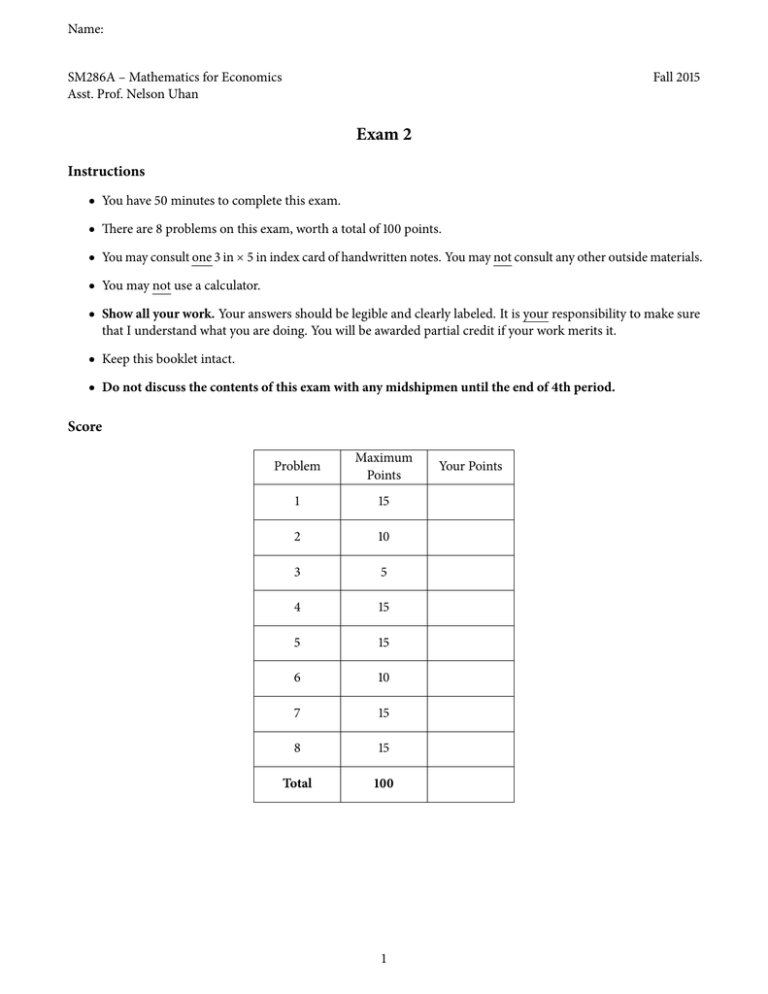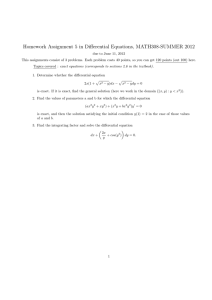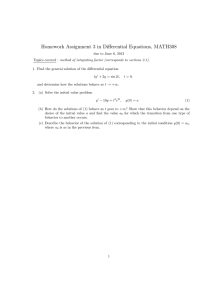Exam 2 Instructions
advertisement

Name: SM286A – Mathematics for Economics Asst. Prof. Nelson Uhan Fall 2015 Exam 2 Instructions ● You have 50 minutes to complete this exam. ● There are 8 problems on this exam, worth a total of 100 points. ● You may consult one 3 in × 5 in index card of handwritten notes. You may not consult any other outside materials. ● You may not use a calculator. ● Show all your work. Your answers should be legible and clearly labeled. It is your responsibility to make sure that I understand what you are doing. You will be awarded partial credit if your work merits it. ● Keep this booklet intact. ● Do not discuss the contents of this exam with any midshipmen until the end of 4th period. Score Problem Maximum Points 1 15 2 10 3 5 4 15 5 15 6 10 7 15 8 15 Total 100 1 Your Points Problem 1. (15 total points) Solve the differential equation dy + 3y = 4e t with the initial condition y(0) = 2. dt Problem 2. (10 total points) Verify that the solution y(t) = 2t 2 − t satisfies the differential equation initial condition y(1) = 1. 2 dy 2 = y + 1 and dt t Problem 3. (5 total points) Is the differential equation t d y + (y2 − y) dt = 0 exact? Why? Problem 4. (15 total points) The differential equation (te y − 1) d y + (2t + e y ) dt = 0 is exact. Solve this equation. 3 Problem 5. (15 total points) 1 Solve the difference equation y t+1 + y t = 8 with the initial condition y0 = 10. 3 Problem 6. (10 total points) The difference equation y t+1 − 2y t = 1 with the initial condition y0 = 2 has the solution y t = 2t − 1. a. (5 points) Is y t oscillatory or nonoscillatory? Why? b. (5 points) Is y t convergent or divergent? Why? 4 Problem 7. (15 total points) Consider the following model of a market with a single product in continuous time. The model variables are P = unit price Qd = quantity demanded Qs = quantity supplied The model equations are: dP 1 = (Qd − Qs ) dt 2 Qd = 8 − 2P 2 Qs = −2 + 8P a. (3 points) Combine these equations to find a single equivalent differential equation. b. (7 points) Plot the phase line of the differential equation you found in part a. Make sure to label the axes. c. (5 points) Suppose the initial price is P(0) = 3. What is the price in the long run? 5 Problem 8. (15 total points) Consider the following version of the Solow growth model. The model variable is k = capital-to-labor ratio The model equation is 3 k̇ = k 2/3 − k 5 a. (10 points) Suppose the initial capital-to-labor ratio is k(0) = 1. Solve the model equation. b. (5 points) What is the capital-to-labor ratio in the long run? 6





